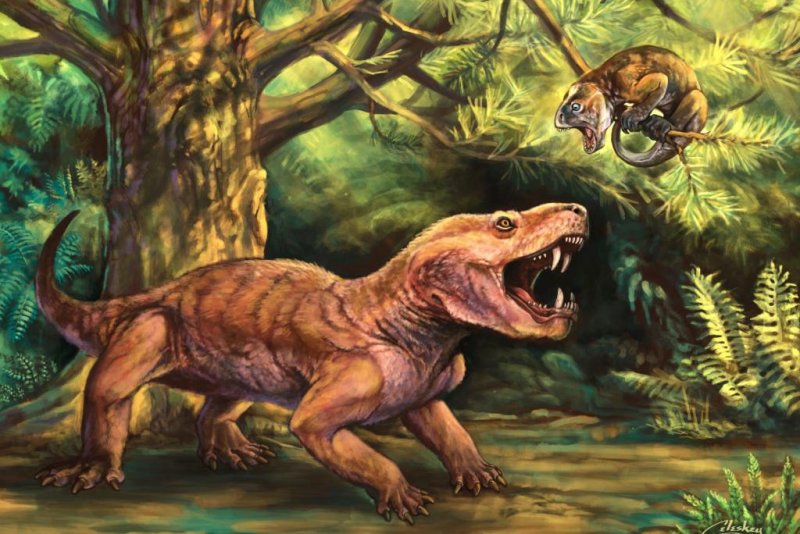An artistic rendering shows a therocephalian Gorynychus masyutinae, an apex predator during the mid-Permian, treeing a small herbivore, Suminia getmanovi. Photo by Matt Celeskey/
June 8 (UPI) -- Two new saber tooth species have been discovered in Russia. The now-extinct species helped scientists more accurately trace the early evolution of mammals.
The species were identified among fossils in collection at the Vyatka Paleontological Museum in Russia. Scientists described the saber tooth cats Friday in two new papers published in the journalPeerJ.
All living mammals descend from a group of proto-mammals called therapsids, which thrived among the terrestrial ecosystems of the Permian Period, from 299 to 252 million years ago. The group comprised burrowing insectivores, tusked herbivores and saber-toothed predators.
Most of what paleontologists know about therapsids is thanks to a rich fossil record recovered from South Africa. As such, remains of the proto-mammals found in other parts of the world offer invaluable perspective, helping scientists determine whether shifts in the therapsid fossil record were the result of regional or global phenomena.
Recent expeditions in Western Russia, near the town of Kotelnich, have turned up several therapsid fossils, including the remains of two new species of saber tooth predators.
Gorynychus masyutinae was wolf-sized carnivore and the largest predator found among the Kotelnich fossils. Nochnitsa geminidens was a slightly smaller carnivore with a long, narrow snout and needle-like teeth.
The new saber tooth predators belong to different subgroups. Gorynychus masyutinae is a member of the "beast heads," or therocephalians, while Nochnitsa geminidens is related to the gorgonopsians, or "gorgon faces."
Both new species are named after monsters from Russian folklore. The beast head, Gorynychus, is named after Zmey Gorynych, a three-headed dragon, while the gorgon face, Nochnitsa, gets its name from an evil nocturnal spirit.
The Permian Period was marked by multiple mass-extinction events. While the die-off that ended the period, which almost wiped out proto-mammals, is more often documented, a mid-period event also disrupted Permian ecosystems.
Prior to the mid-Permian extinction event, as evidenced by the newly described fossils, gorgonopsians were the larger more dominant group, while therocephalians most consisted of smaller insectivores. Late-Permian fossils show their roles became reversed in the aftermath of the mid-Permian extinction event.
"In between these extinctions, there was a complete flip-flop in what roles these carnivores were playing in their ecosystems -- as if bears suddenly became weasel-sized and weasels became bear-sized in their place," Christian Kammerer, paleontologist at the North Carolina Museum of Natural Sciences, said in a news release.
The new research proves this reversal was a global phenomenon.
"Kotelnich is one of the most important localities worldwide for finding therapsid fossils -- not only because they are amazingly complete and well-preserved there, but also because they provide an all-too-rare window into mammal ancestry in the Northern Hemisphere during the Permian," Kammerer said.















